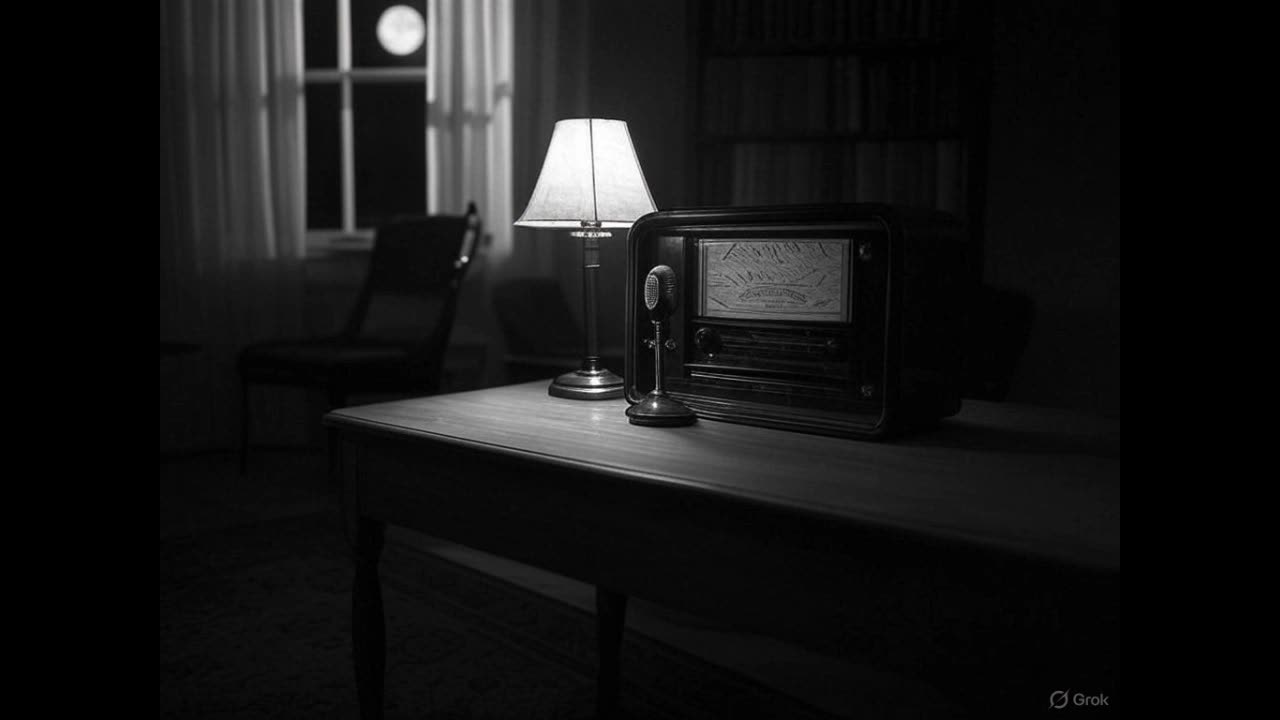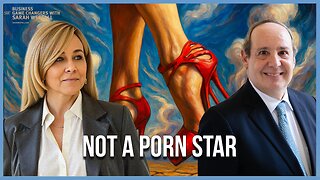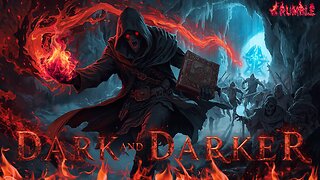Premium Only Content

Lights Out episode titled “The Story of Mr. Maggs” (December 1, 1942)
Episode: “The Story of Mr. Maggs” (December 1, 1942)
Cast and Roles
Arch Oboler as Host/Writer/Director: Oboler introduces the episode with his signature eerie line, “It… is… later… than… you… think,” setting a chilling tone. He likely provides narration or minor voice roles, as was common in the 1942–43 CBS revival.
Lead Actor(s) (Unknown, likely ensemble players): Lights Out typically used a small cast of versatile CBS radio actors from New York or Hollywood. The lead, presumably Mr. Maggs, is likely a male character—an everyman, possibly a salesman, clerk, or loner—caught in a supernatural or psychological horror. A female co-star, perhaps a wife, neighbor, or mysterious figure, adds emotional or narrative tension. Actors like Mercedes McCambridge, Lou Merrill, or Joseph Kearns, who appeared in other 1942 episodes, are possible but unconfirmed.
Supporting Actors: Additional voices for secondary characters (e.g., townsfolk, supernatural entities, or family members), provided by actors doubling roles. The focus was on Oboler’s script and sound effects rather than star power.
CBS Sound Crew: Uncredited but crucial, they created atmospheric effects like footsteps, creaking doors, ghostly whispers, or otherworldly hums, essential to the episode’s horror ambiance.
Note: Exact cast details are unavailable, as Lights Out rarely credited actors in surviving records, and this episode’s documentation is sparse. The 1942–43 run, sponsored by Ironized Yeast, relied on Oboler’s direction and CBS’s production quality, emphasizing sound and story over named performers.
Episode Summary
“The Story of Mr. Maggs” aired on CBS on December 1, 1942, as part of Arch Oboler’s 1942–43 Lights Out revival, broadcast at 8:00 p.m. ET in a prime-time, family-accessible slot. This 27-minute episode, available on the Internet Archive, is a supernatural or psychological horror tale likely centered on the titular Mr. Maggs, an ordinary man facing an extraordinary terror. While no detailed synopsis exists in public archives, the title and Oboler’s style allow for a plausible reconstruction:
Opening: Oboler begins with a tolling bell and his ominous warning, urging nervous listeners to turn off their radios. He introduces the story as a tale about Mr. Maggs, a seemingly unremarkable man whose life takes a dark turn, setting a foreboding mood.
Plot: The story likely follows Mr. Maggs, an average individual—perhaps a middle-aged clerk, salesman, or widower—whose mundane routine is disrupted by a supernatural force. The title suggests a personal, character-driven narrative, typical of Oboler’s focus on psychological dread. Mr. Maggs might encounter a ghostly apparition, a cursed object, or a mysterious stranger who draws him into a nightmarish scenario. Sound effects like echoing footsteps, howling wind, or distorted voices create an unsettling atmosphere. Oboler may explore themes of isolation, guilt, or fate, with Mr. Maggs confronting a past sin or an inescapable destiny. A female character—possibly a wife, daughter, or enigmatic figure—adds emotional stakes or serves as a catalyst for the horror.
Climax and Twist: Oboler’s stories often hinge on a shocking twist. Mr. Maggs might discover he’s dead, trapped in a purgatorial loop, or that the supernatural force is a manifestation of his own psyche. Alternatively, he could face a grim fate, such as being consumed by the entity or losing his sanity. The climax likely uses intense sound design—screams, otherworldly noises, or a sudden silence—to evoke terror.
Resolution: The episode probably concludes with Oboler’s narration, offering a cryptic moral about human vulnerability, the unknown, or the consequences of one’s actions, followed by a jarring shift to a cheerful Ironized Yeast commercial, a hallmark of radio’s tonal contrast. The story leaves listeners unsettled, pondering the thin line between reality and the supernatural.
Tone and Style: The episode blends psychological horror with a character-driven narrative, using Oboler’s stream-of-consciousness narration and vivid sound effects. It’s less gory than earlier Lights Out episodes, reflecting the prime-time slot, but eerie enough to captivate a broad audience, including families.
Note: Without a surviving transcript or detailed summary, the plot is inferred from the title and Oboler’s recurring motifs (e.g., ordinary characters facing supernatural terror, psychological twists). If you’d like me to search for audio or fan discussions on X to refine the summary, let me know!
U.S. News on December 1, 1942
Based on historical records and news archives for December 1, 1942:
Beveridge Report Reaction: On December 1, U.S. newspapers reported on Britain’s Beveridge Report, released that day, which proposed a comprehensive welfare state. American outlets like The New York Times analyzed its implications, sparking debates about postwar social programs in the U.S., though overshadowed by war news.
Rationing Intensifies: Gasoline rationing began nationwide on December 1, limiting drivers to three gallons per week to conserve resources for the war effort. Reports highlighted public adjustments to ration books and carpooling, alongside ongoing shortages of coffee, sugar, and meat.
War Bond Campaigns: The U.S. Treasury pushed war bond sales to fund the military. On December 1, radio and newspapers featured celebrities like Kate Smith promoting bonds, tying into the era’s patriotic fervor.
Chicago Pile-1 Milestone: On December 2, 1942 (one day later), Enrico Fermi’s team achieved the first controlled nuclear chain reaction at the University of Chicago. While not public on December 1, preliminary reports of atomic research circulated in scientific circles, foreshadowing the Manhattan Project’s impact.
These events reflected a nation deeply engaged in World War II, with radio shows like Lights Out offering a thrilling escape from rationing and war anxieties.
International News on December 1, 1942
Battle of Stalingrad: The Soviet Union’s defense of Stalingrad remained a global focus. On December 1, international dispatches reported the Red Army’s counteroffensive (Operation Uranus, launched November 19) encircling German forces, marking a turning point in World War II.
North Africa Campaign: Allied forces advanced after Operation Torch and the Second Battle of El Alamein. On December 1, news highlighted U.S. and British troops pushing toward Tunisia, facing German reinforcements under General Hans-Jürgen von Arnim.
Pacific Theater: The Guadalcanal Campaign continued, with Allied forces solidifying gains after the Naval Battle of Guadalcanal (November 12–15). On December 1, reports noted ongoing skirmishes and Japan’s struggle to reinforce the island, signaling Allied momentum.
Holocaust Reports: In late November, the U.S. and Allies received confirmed reports of Nazi death camps. On December 1, diplomatic channels discussed Jewish deportations, though public awareness remained limited, overshadowed by military news. The New York Times ran early stories on atrocities, but they were buried in inside pages.
These global stories underscored a world consumed by war, with Lights Out providing a supernatural diversion from relentless battle reports.
Cultural Impact, If Any
“The Story of Mr. Maggs” had limited direct cultural impact as a single broadcast in the 1942–43 Lights Out revival, but its context and themes contributed to broader cultural trends:
Everyman Horror: The focus on Mr. Maggs, likely an ordinary man facing extraordinary terror, tapped into wartime anxieties about personal vulnerability amid global chaos. Its relatable protagonist allowed listeners to project their fears—of war, loss, or the unknown—onto a supernatural narrative, offering a safe outlet for tension.
Oboler’s Radio Innovation: Arch Oboler’s use of psychological horror and sound-driven storytelling in “The Story of Mr. Maggs” reinforced Lights Out’s status as a pioneer of radio drama. His techniques—minimal casts, vivid sound effects, and introspective narration—influenced later horror shows like Suspense and modern audio formats like podcasts.
Wartime Escapism: Airing during World War II’s darkest months, the episode provided a thrilling distraction for families gathered around radios. Its prime-time slot made horror accessible to a broader audience than the show’s earlier midnight runs, though toned down to suit families, aligning with radio’s role as a wartime morale booster.
Ephemeral Legacy: As a lesser-known episode, “The Story of Mr. Maggs” lacks the fame of Lights Out classics like “Cat Wife” or “Chicken Heart.” Its survival in archives ensures niche appeal among old-time radio fans, but it didn’t inspire specific adaptations or cultural references. Its significance lies in sustaining the series’ wartime relevance and horror innovation.
-
 1:16:04
1:16:04
Rebel News
3 hours agoHealth-care collapsing, Bloc says Quebec sends Alberta $, US Ambassador's advice | Rebel Roundup
13.6K16 -
 1:44:03
1:44:03
The Shannon Joy Show
4 hours agoThe BEST Of Shannon Joy 2025! Special Thanksgiving Holiday Compilation
19.3K -
 1:07:25
1:07:25
Sarah Westall
19 hours agoSarah Westall is Not a Porn Star – Conversation w/ Stuart Brotman
14.7K12 -
 2:59:36
2:59:36
Wendy Bell Radio
11 hours agoPoint Blank Hate
82.6K111 -
 4:56:43
4:56:43
MrR4ger
9 hours agoWARLOCK SOLO SELF FOUND HARDCORE - D4RK AND D4RKER HAPPY TURKEY DAY RUMBLEFAM
21.6K1 -
 1:33:31
1:33:31
Barry Cunningham
16 hours agoBREAKING NEWS: KASH PATEL AND DOJ HOLD PRESS CONFERENCE UPDATE ON NATIONAL GUARD ATTACK
127K73 -
 1:22:22
1:22:22
iCkEdMeL
7 hours ago $14.51 earned🔴 BOMBSHELL: DC Shooter Worked With CIA-Backed Unit in Afghanistan, Officials Say
31.3K27 -
 17:28
17:28
Tactical Advisor
1 day agoComparing the NEW Cloud Defensive EPL
27.1K1 -
 LIVE
LIVE
freecastle
15 hours agoTAKE UP YOUR CROSS- THANKSGIVING MUSIC EXTRAVAGANZA!
20 watching -
 57:54
57:54
A Cigar Hustlers Podcast Every Day
11 hours ago $1.65 earnedCigar Hustlers Podcast Evere Week Day w/Steve Saka
18.5K1